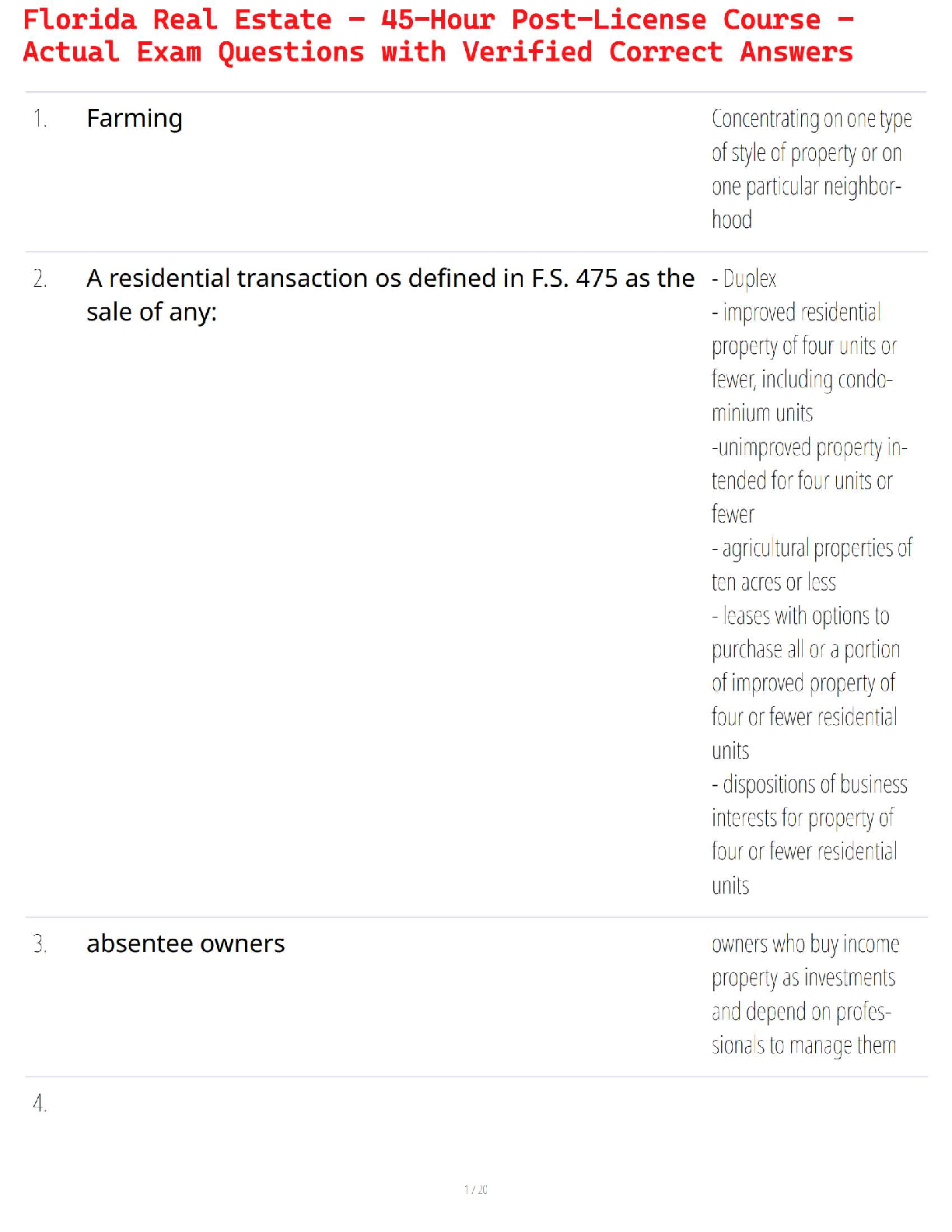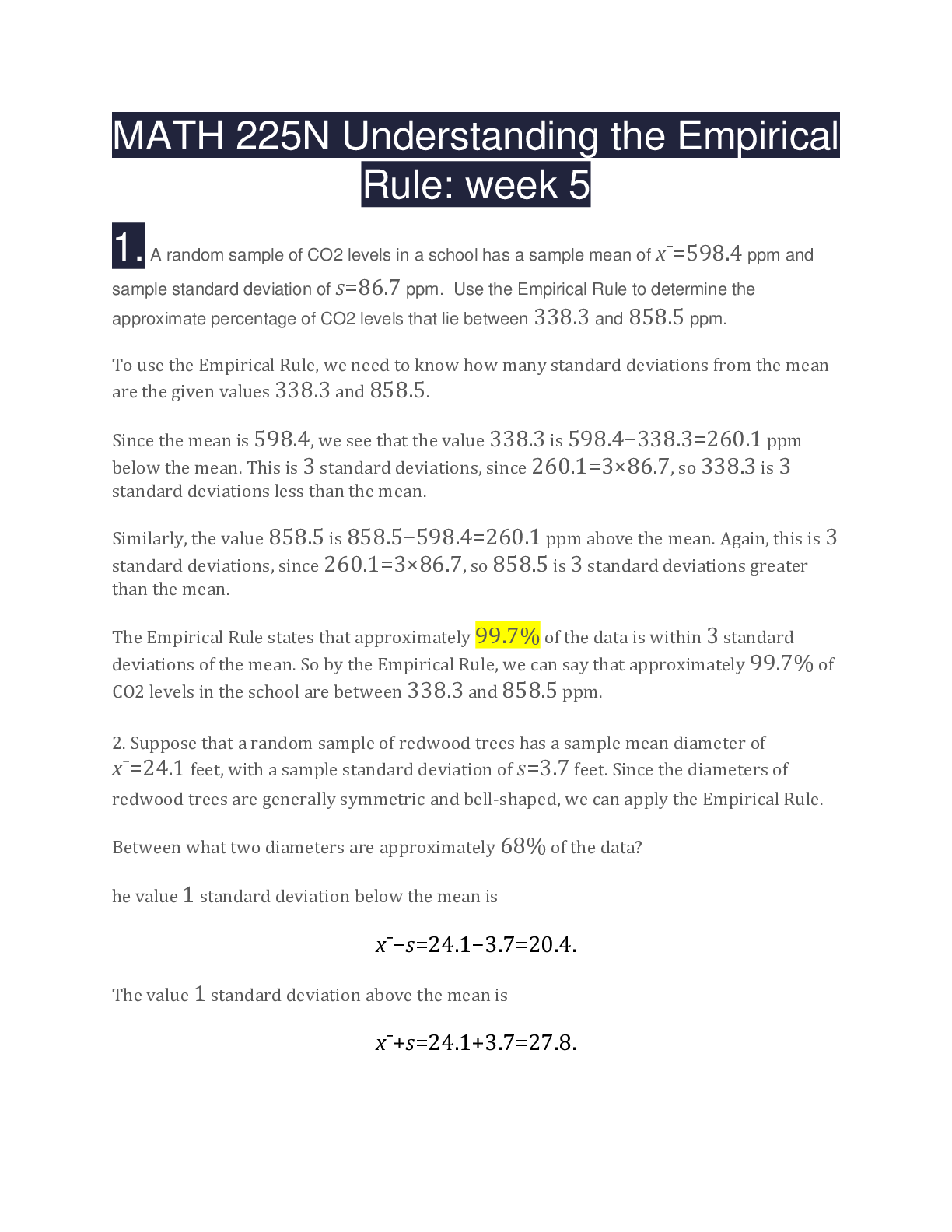
Florida Real Estate – 45-Hour Post-License Course – Actual Exam Questions with Verified Correct Answers
Health Care > QUESTIONS & ANSWERS > MATH 225N Understanding the Empirical Rule: Week 5 (summer 2020) complete answers solution guide. (All)
MATH 225N Week 5 Understanding the Empirical Rule 1. Question: A random sample of CO2 levels in a school has a sample mean of x¯=4 ppm and sample standard deviation of s=86.7 ppm. Use the Empirical ... Rule to determine the approximate percentage of CO2 levels that lie between 338.3 and 858.5 ppm. 2. Question: Suppose that a random sample of redwood trees has a sample mean diameter of x¯=1 feet, with a sample standard deviation of s=3.7 feet. Since the diameters of redwood trees are generally symmetric and bell-shaped, we can apply the Empirical Rule. Between what two diameters are approximately 68% of the data? 3. Question: Suppose a random sample of monthly rainfalls in a given area has a sample mean of x¯=2 inches, with a sample standard deviation of s=3.5 inches. Since rainfall amounts in this area are generally symmetric and bell-shaped, we can apply the Empirical Rule. Between what two amounts are approximately 99.7% of the data? 4. Question: Suppose a random sample of adult women has a sample mean height of x¯=3 inches, with a sample standard deviation of s=2.4 inches. Since height distribution are generally symmetric and bell-shaped, we can apply the Empirical Rule. Between what two heights are approximately 99.7% of the data? 5. Question: For the same random sample of adult women, with a sample mean height of x¯=3 inches and sample standard deviation of s=2.4inches, use the Empirical Rule to determine the approximate percent of heights that lie between 59.5 inches and 69.1 inches. 6. Question: Returning to the sample of adult women, with a sample mean height of x¯=3 inches and sample standard deviation of s=2.4 inches, use the Empirical Rule to estimate the percentage of heights that are less than 61.9 inches. 7. Question: A random sample of males has a sample mean blood volume of x¯=2 liters, with a sample standard deviation of s=0.2 liters. Since blood volumes in males are generally symmetric and bell-shaped, we can apply the Empirical Rule. Between what two volumes are approximately 95% of the data? 8. Question: A random sample of men’s weights have a sample mean of x¯=3 pounds and sample standard deviation of s=12.7 pounds. Use the Empirical Rule to determine the approximate percentage of men’s weights that lie between 156.9 and 207.7 pounds. 9. Question: A random sample of waiting times at a bus stop has a sample mean time of x¯=6 seconds, with a sample standard deviation of s=29.4 seconds. Since waiting times at this bus stop are generally symmetric and bell-shaped, we can apply the Empirical Rule. Between what two waiting times are approximately 95% of the data? 10. Question: Suppose a random sample of monthly temperatures in a given area has a sample mean of x¯=2∘F, with a sample standard deviation of s=1.5∘F. Since temperatures in this area are generally symmetric and bell-shaped, we can apply the Empirical Rule. Between what two temperatures are approximately 99.7% of the data? 11. Question: A random sample of small business stock prices has a sample mean of x¯=$82 and sample standard deviation of s=$8.95. Use the Empirical Rule to estimate the percentage of small business stock prices that are more than $81. [Show More]
Last updated: 3 years ago
Preview 1 out of 6 pages

Buy this document to get the full access instantly
Instant Download Access after purchase
Buy NowInstant download
We Accept:

Can't find what you want? Try our AI powered Search
Connected school, study & course
About the document
Uploaded On
Apr 26, 2020
Number of pages
6
Written in
All
This document has been written for:
Uploaded
Apr 26, 2020
Downloads
0
Views
151
Scholarfriends.com Online Platform by Browsegrades Inc. 651N South Broad St, Middletown DE. United States.
We're available through e-mail, Twitter, Facebook, and live chat.
FAQ
Questions? Leave a message!
Copyright © Scholarfriends · High quality services·